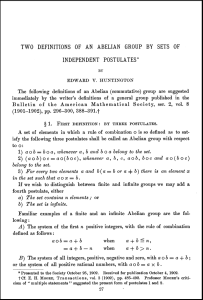At the beginning of the twentieth century, some minor algebraic investigations grabbed the interest of a small group of American mathematicians. The problems they worked on had little impact at the time, but they may nevertheless have had a subtle effect on the way in which mathematics has been taught over the past century.
The work in question is labelled postulate analysis. By 1900, several objects of mathematical study had been axiomatised – that is, their important properties had been identified and assembled into self-contained lists of defining conditions (axioms or postulates). The postulate analysts typically turned their attention to axiomatisations of systems formed by a set of elements subject to a given operation: for example, the integers with respect to addition, or the rational numbers under multiplication, or other more exotic constructions. Thus, to give an example, suppose that we wanted to find a collection of postulates for the integers with respect to addition. We would notice, for instance, that addition is associative, i.e., given any three integers a, b, c, it will always be the case that a + (b + c) = (a + b) + c. We might therefore take the condition of associativity as a defining postulate. Likewise, the integers are commutative under addition (a + b = b + a, for any integers a, b), so here we have another possible postulate. The goal is to come up with a list of postulates that completely describes the system in question.
One of the main obsessions of the postulate analysts was to ensure that the sets of postulates that they had to hand were independent. To continue with the example of the integers under addition, suppose that we have constructed a set of postulates for the integers which includes the associative and commutative conditions noted above, and also includes, among other things, the further condition that a + (b + c) = (b + a) + c. This latter condition is, however, dependent on the associative and commutative conditions: all we have to do is apply the commutative law to the bracketed part of the right-hand side of the associative law, and we obtain our new condition. This latter condition is therefore redundant within our collection of postulates, and can safely be dropped. The postulate analysts experimented with the inclusion of different postulates in order to ensure that their lists were independent.
The question that arises immediately is: what is the point? How does the removal of redundancy affect the overall mathematics? The answer: it doesn't. We’ve merely tidied up the mathematics. The investigations of the postulate analysts had a significant aesthetic element, although they argued also that they were increasing the understanding of the objects with whose postulates they were tinkering. However, most mathematicians disagreed, and by the middle of the twentieth century, postulate analysis had all but died away. Many of the prominent postulate analysts are still remembered today, but for other things. For example, E. V. Huntington of Harvard, the most prolific of the postulate analysts, is now best remembered for his work on voting systems: the method currently used to appoint representatives to the US Congress was devised by him.
Although it doesn't appear to have gone anywhere, there is still value in looking at the work on postulate analysis that appeared briefly at the beginning of the twentieth century. It reminds us, for example, that mathematics has its fashions, just the same as any other human endeavour. And it seems also that over the course of the twentieth century some of the basic methods of the postulate analysts found their way into elementary mathematics textbooks: the kind of algebraic manipulations of postulates that they carried out may often be found in preliminary exercises, whose value lies not in their answers but in the methods used to arrive at them. Such exercises that serve to train students in particular ways of logical thinking are arguably the legacy of the postulate analysts.
A study of the work of the postulate analysts by Oxford Mathematician Christopher Hollings may be found in here.


